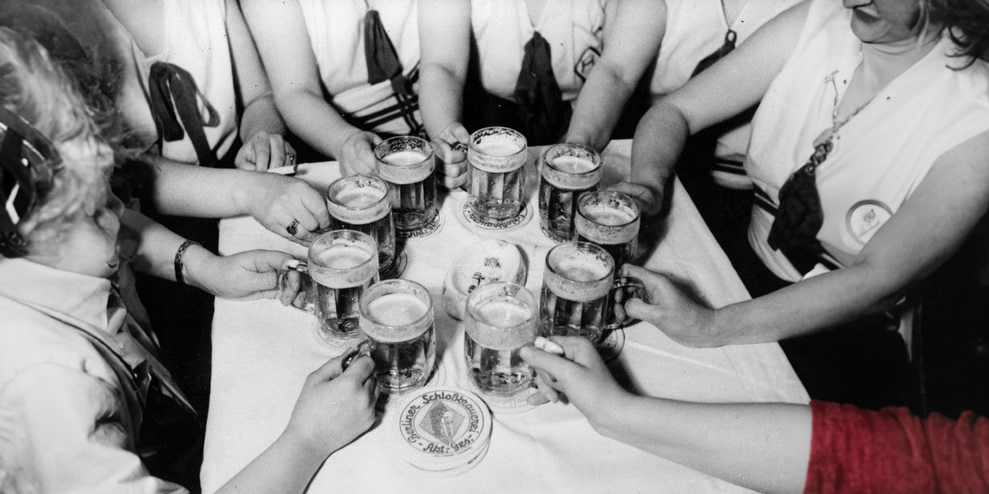The Decline of the Brew
It’s Friday, so I’ll go ahead and say it: I love cracking open a cold one. It’s not just the taste of beer itself or the alcohol. For me, drinking a beer is also about the pleasure of the ritual. Indeed, so much do I enjoy cracking open cold ones that I also often drink hop water, nonalcoholic seltzers flavored with hops. (They taste good and have the added benefit of making me feel virtuous.)
On Tuesday evening, I was lying on my chaise lounge, reading a magazine and sipping a new variety of hop water, which I had nestled into a koozie emblazoned with a crab and the words “Don’t bother me I’m crabby.” I was relaxed. So imagine my surprise when I looked at the can and discovered that the drink contained adaptogens and nootropics. I don’t really know what those are; I can barely pronounce the latter. I thought I was just drinking sparkling water with a bit of flavoring! Did I feel a bit weird because I was tired, I suddenly wondered, or because there were supplements in my hop water? Would this drink make me a genius?
In recent years, canned and bottled beverages of every stripe have proliferated. Canned cocktails, hard seltzers, ciders, nonalcoholic beers, CBD drinks, and hop waters share shelf space with traditional beer. It can be hard to keep up. Changing consumer preferences, the high costs of doing business, and competitive pressure mean that the beer industry is not the retail big dog it once was. Beer once held a hefty lead in the market over other alcoholic drinks. Not anymore. Lester Jones, the chief economist of the National Beer Wholesalers Association, told me that the market shrank by 3 percent in volume last year, continuing a downward trend that began around 2000, and we’re now in the midst of one of the worst years so far since beer’s decline began.
Part of the reason for the contraction in beer-volume sales is that people are diversifying their alcohol consumption, adding drinks such as spirits to the rotation. Whereas beer prices have roughly tracked with inflation over the past 20 years, liquor has gotten relatively cheaper, Bart Watson, the chief economist of the Brewers Association, a craft-beer trade organization, told me. For more than a decade, spirits have been gaining market share. Demographic shifts also tell part of the story: The American population is older than ever before. As Boomers age into retirement and Millennials enter their 40s, they are reaching for different drinks for different types of occasions. A retiree might enjoy an expensive bottle of wine with dinner, and a Millennial might mix cocktails for a birthday celebration. (Or, if you’re me, you might break out a hop water while chilling.)
The next generation is not waiting in the wings to replace them. Young people “are just drinking less beer,” Watson said, and many seem to be buying less alcohol, in general. Those who are drinking have a panoply of options to choose from. No longer are college kids just guzzling Natty Light and slapping bags of Franzia. Now young people are turning 21 and entering a market filled with relatively affordable seltzers, canned cocktails, and ciders—not to mention EANABs, the name my college dorm used to describe Equally Attractive Nonalcoholic Beverages.
For those who do still drink beer, preferences are shifting in how much beer they want to buy and what kind. “People are drinking less beer, but they are drinking higher-priced beer,” Jones explained, as some mass-produced beers have gotten more expensive, and pricier craft beer now occupies more of the market. Premium light beers have been losing market share for years, Watson told me.
Then, this spring, light beer got an unwelcome turn in the spotlight when a right-wing campaign to cancel Bud Light picked up steam. Consumers boycotted the beer after Dylan Mulvaney, a transgender influencer, posted a promotional video for the brand on Instagram. In June, after 20 years as America’s best-selling beer, Bud Light was surpassed by Modelo. That was not totally unexpected—“it was a question of when, not if” Modelo would reach the top, Watson told me, though the backlash accelerated the trend. For years, Modelo had been on track to surpass Bud Light as consumers began gravitating toward more expensive, imported beers.
In the aftermath of the backlash, two Bud Light executives went on leave. As it happens, I interviewed one of them, Alissa Heinerscheid, last January, before all of this happened. In her capacity as vice president of marketing for Bud Light, Heinerscheid told me at the time that the brand’s 2023 Super Bowl ad, featuring a breezy scene of a couple dancing while drinking the beer, was going for a “lighter and brighter” energy than in years past (notable past ads include Budweiser’s “Wasssuuuup” and Bud Light’s original party animal, Spuds MacKenzie). A couple of months later, on a podcast, she discussed her interest in reaching new audiences and making the brand’s image less “fratty” in hopes of turning around a brand in decline. In trying to carry out that mission to engage new customers, she met an audience—or at least a vocal portion of it—that was unwilling to accept changes that would make the brand more inclusive. (Anheuser-Busch, the parent company of Bud Light, did not respond to a request for comment.)
The beverage sector will likely keep changing—or at least keep trying to change—to meet the moment. For many alcohol brands, that could look like adding seltzers and other canned delicacies to the mix. Anheuser-Busch now owns seltzer, canned-cocktail, and hard-tea brands. And in 2020, Molson Coors Brewing Company undertook a telling rebrand: It’s now called Molson Coors Beverage Company.
—
This article first appeared on www.marketingmag.com.au
Seeking to build and grow your brand using the force of consumer insight, strategic foresight, creative disruption and technology prowess? Talk to us at +971 50 6254340 or engage@groupisd.com or visit www.groupisd.com/story


